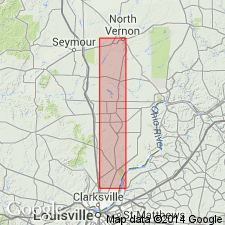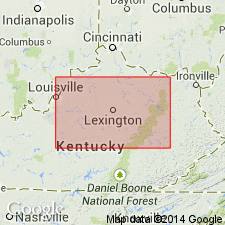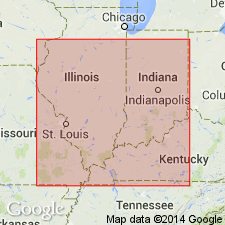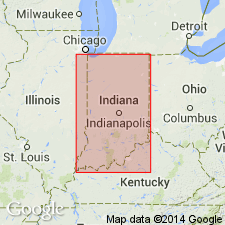
- Usage in publication:
-
- Morgan Trail Member
- Modifications:
-
- Named
- Dominant lithology:
-
- Shale
- AAPG geologic province:
-
- Illinois basin
- Cincinnati arch
Summary:
Name Morgan Trail Member of New Albany Shale here formally proposed for brownish-black, carbon-rich, fissile, quartzose, pyritic shale in southern and eastern IN. Unit contains numerous hard quartzose pyritic beds less than 1 in. thick. Thickness ranges from 24 to 40 ft. Overlies Selmier Member (new name) and underlies Camp Run Member (new name). Corresponds to upper part of lower member of Blackiston Formation of Campbell (1944) (abandoned in IN). Rocks equivalent to the Morgan Trail Member are included in the Antrim Shale of the Michigan basin and in the lower part of the Grassy Creek Shale (New Albany Group) of IL. Age is Late Devonian.
Source: GNU records (USGS DDS-6; Reston GNULEX).

- Usage in publication:
-
- Morgan Trail Member
- Modifications:
-
- Overview
- AAPG geologic province:
-
- Illinois basin
Summary:
Authors follow de Witt (1981) in restricting the New Albany Shale to the Illinois basin and the Ohio Shale to the Appalachian basin. Ohio Shale terminology used wherever Three Lick Bed is recognizable in cores. Unlike de Witt (1981), authors do not use Chattanooga Shale in Knobs outcrop area of south-central KY. Most of New Albany correlates with the Huron Member of Ohio Shale. Upper 1 to 2 m correlates with Cleveland Member. New Albany subdivided into (ascending) Blocher, Morgan Trail, Camp Run, and Clegg Creek Members.
Source: GNU records (USGS DDS-6; Reston GNULEX).

- Usage in publication:
-
- Morgan Trail Member
- Modifications:
-
- Overview
- AAPG geologic province:
-
- Illinois basin
Summary:
In the outcrop area of the New Albany Shale of southeastern IN, the Morgan Trail, Camp Run, and Clegg Creek Members are differentiated above the Selmier Member. They are also recognized in the subsurface of west-central KY. Together the three members reach a thickness of 140 ft in Posey and Vanderburgh Cos, IN, but thin to 60 ft in central and northern IN. They are mapped as undifferentiated in southwestern IN. The Morgan Trail consists mainly of fissile, siliceous, brownish- to olive-black shale with pyritic, calcareous laminae and beds. In the subsurface of IN, unit thins northward from 38 ft in Clark Co. to 7 ft in Bartholomew Co. Presumed to be stratigraphically equivalent to the lower part of the Grassy Creek of IL and western KY.
Source: GNU records (USGS DDS-6; Reston GNULEX).

- Usage in publication:
-
- Morgan Trail Member*
- Modifications:
-
- Biostratigraphic dating
- AAPG geologic province:
-
- Illinois basin
- Cincinnati arch
Summary:
Conodont biostratigraphy indicates that the Morgan Trail Member of the New Albany Shale is of Late Devonian (Famennian) age. Conodonts from the TRIANGULARIS and CREPIDA Zones were recovered. Unit overlies the Selmier Member and underlies the Camp Run Member, both of the New Albany Shale.
Source: GNU records (USGS DDS-6; Reston GNULEX).
For more information, please contact Nancy Stamm, Geologic Names Committee Secretary.
Asterisk (*) indicates published by U.S. Geological Survey authors.
"No current usage" (†) implies that a name has been abandoned or has fallen into disuse. Former usage and, if known, replacement name given in parentheses ( ).
Slash (/) indicates name conflicts with nomenclatural guidelines (CSN, 1933; ACSN, 1961, 1970; NACSN, 1983, 2005, 2021). May be explained within brackets ([ ]).

